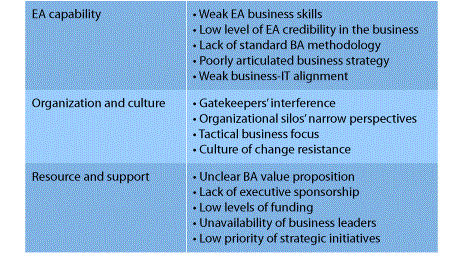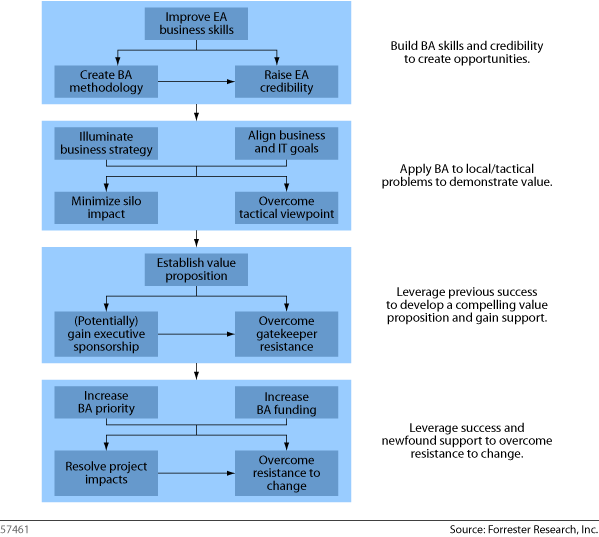The Enterprise Business Architecture, Part 2
Image Source: DesignBoom
Architectural Photographer and Artist, Filip Dujardin, has a special talent. He can create images such as the photo above, which, at first glance, appear unusual yet somewhat plausible. Upon careful inspection, though, these buildings are actually impossible. He is able to take multiple digital elements and create these surreal buildings. According to Dujardin, “the building becomes real if the shadows are well done.”
So what does that have to do with Business Architecture?
The fact is that many organizations claim to have setup an Enterprise Architecture including the Business Architecture viewpoint, but in reality it’s just on paper. It’s not real..!!! Even if the organization claims to have been successful, there is no tangible benefit that is being realized. In fact, roughly 2/3 of all EA initiatives are considered to have failed.
Specifically in the Business Architecture arena, only a small percentage of programs are actually delivering value back to the organization. Forrester published a report in 2010 listing the top 14 Business Architecture Challenges and some recommendations on how to overcome those challenges. Instead of regurgitating what author Jeff Scott wrote, I think his article stands on it’s own (Scott, 2010):
Fourteen Business Architecture Challenges And How To Overcome Them
EAs Are Challenged By Their Own Business Architecture Capabilities
Though business architecture has been part of the basic EA model from its inception, only in recent years have EAs focused there. Business architecture knowledge, skills, and methodology are all lagging general EA by a decade or more, and because business architecture is fundamentally different from technology architecture, the learning curve is very steep. The good news is that EA teams can overcome these challenges without much help or support from the rest of the organization. The following challenges are within EA’s scope to resolve:
- Weak EA business skills. Most EA teams are composed of some of the organization’s strongest technologists. Their past experience, interest, and current EA roles keep them overly focused on technology topics with little time — and often little inclination — to improve their business and business architecture knowledge. Successful business architects are allocating time to read business books, interact with business mentors, and learn about the fundamentals of their company’s business model. Non-IT-based business architects come to the table with M.B.A.s and business-specific experience.
- A low level of EA credibility in the business. Fifty-four percent of EA teams report to a senior-level executive such as a CIO or CTO, while the rest report lower in the IT organization. With little business visibility, many aspiring business architects are virtually unknown to business leaders. In addition, many EA teams have unintentionally created a negative impression through their efforts to hold project teams to architectural standards. Successful EA teams position the EA practice as a project resource as opposed to a controlling function, thereby turning their IT peers into business architecture (BA) advocates who promote them to the business.
- A lack of industry-standard business architecture methodology. Business architecture is still in its infancy. While there are a number of “meta methodologies” in the public domain, they are neither comprehensive nor robust. Business architects are still experimenting with which approaches work best. For the foreseeable future, business architects will have to craft their methodology from what is available and continue to evolve it over time.
- Poorly articulated business strategy. Many architects might disagree that this is an EA team issue, but Forrester believes it is a core responsibility of the business architect to identify, clarify, and document business intent. Business leaders are skeptical of the value of a documented business strategy because they have rarely seen a good one. Often architects address this challenge informally, gaining small wins with the business before tackling an enterprise view. Architects that create a well-articulated view of business strategy report an “aha” reaction from their business executives.
- Weak business-IT alignment. Contributing to many EA teams’ lack of business credibility is the fact that they reside in an IT organization that is poorly aligned with business goals. Architects take one of two opposing strategies to overcome this challenge. One is to meet it head-on and apply EA and business architecture specifically to helping improve alignment. The other is to distance EA from the IT culture to present a different viewpoint to the business.
EAs Are Challenged By The Business Culture That Surrounds Them
While BAs are still trying to figure out what a really great business architecture looks like, they are facing an even bigger challenge in connecting with organizations that are not designed or predisposed to work in a coordinated, strategic fashion. The organization and cultural challenges BAs face are:
- IT gatekeepers who prevent EA’s interaction with the business. Most IT organizations have established business relationship managers as a formal or informal role. Whether they are project managers or senior IT executives, they play an important role in managing the business relationship by providing a single point of contact and by isolating the business from many of the day-to-day nuances of managing IT. Strong gatekeepers create a formidable challenge to EA, and successful architects most often partner with them as opposed to try to circumvent them.
- Organizational silos that make it difficult to get the big picture. Business unit independence is the norm and is a natural occurrence spawned by dealing with span of control challenges. Successful business architects use this to their advantage by cultivating a relationship with one business unit and leveraging success there to gain access to others.
- A tactical business focus. Quarterly financial reporting, a lack of corporate strategic thinking, and the fast pace of business environment change drive short-term business thinking. Convincing business leaders to explore a strategic viewpoint is challenging. Successful approaches to this challenge usually begin with finding a specific problem business architecture can solve as opposed to trying to sell the larger concept.
- A culture of change resistance. Almost all organizations resist change unless their business model is based on product innovation. Resistance to change is a very powerful force, as it is usually rooted within each individual’s perspective of what he or she has to do to be successful. Resistance to change can rarely be “solved” but instead must be managed. Architects who manage change well first develop a plan to understand the factors that are creating resistance and then attack those issues by lowering the perceived risk of doing something different.
EAs Are Challenged By Lack Of Support And Resources
Architects can’t build business architecture in a vacuum. They need the support, or at least the attention, of a number of businesspeople at various levels of the organization. Most business architecture efforts are small and only require minimal funding; however, like any other initiative, they do need money — and the more they have, the faster they can proceed. Developing a clear value proposition can be the most challenging aspect of building business architecture. The resource and support challenges BAs face are:
- Business architecture has yet to establish a compelling value proposition. Business architecture is still relatively new; few companies are far enough along the path to report the value they are receiving. As with other EA domains, BA value is hard to specify until architects do enough work to show results. Current BA approaches that are showing results typically focus on specific problems or a single business unit.
- Business architecture rarely has executive sponsorship. Though many architects list executive sponsorship as a critical success factor (CSF), few are reporting that they have it. Securing sponsorship is somewhat of a “chicken and the egg” problem. Architects want sponsorship to drive support for BA but generally have to make enough progress to demonstrate value to gain sponsorship. Architects that do gain executive sponsorship typically first show results at a project or departmental level.
- EA teams rarely have specific business architecture funding. Without a clear and compelling value proposition, most EA teams find that BA funding is limited. Many have made the case to hire a single business architect to round out the EA team, but few have established funding for specific BA initiatives. Successful BA startup efforts leverage a small number of resources to manage a larger number of non-EA participants.
- Availability of business resources is low. Business executive and senior management time is a scarce commodity. Most business managers are overworked, often finding themselves with a full calendar of meetings most days. Consequently, they are very careful about committing the little free time they have. Executive sponsorship can overcome this challenge, but most BAs are forced to work at a lower level with the intent to move up in the organization as they produce results.
- Strategic activities have low priority. Most organizations are tactically focused with little appreciation of the strategic value of architecture and strategy. Most business managers are accustomed to seeing strategy efforts as a waste-of-time planning exercise. BAs report making headway when they judiciously apply strategic tools to help solve current problems.
The Solution is in the Connection of the Challenges
Taken individually, these challenges can seem overwhelming, but this is a problem of not seeing the forest for the trees. Putting the challenges in context creates a clear picture of how to proceed (see figure below). To tame these BA challenges:
- Assess the challenges you face. Not all business architects will face all 14 challenges, nor will each challenge present the same level of difficulty. Lay out the challenges in road map form that clarifies your business architecture effort’s current position and indicates future steps. Focus your attention and energy on the next challenge you need to address.
- Build foundational success first. Though the solutions are not completely as sequential as Figure 3 indicates, building a strong foundation is crucial to achieving long-term success. In general, executive sponsorship and funding can only be solved when you have a compelling value proposition, which you can only create once you have demonstrated value in some way, which you can only do when you have the right skills and capabilities. Attempting to skip steps will only lead to frustration and additional work to recover lost ground.
- Demonstrate value to overcome organizational challenges. Organizations will rarely get behind a BA initiative because it is the right thing to do. Everyone wants to know “what’s in it for me?” Find opportunities to add value to build up credibility. Typical places business architects are getting early traction are in business transformation projects, business-IT alignment initiatives, annual IT and business planning exercises, merger and acquisition activities, and large process improvement initiatives.
References:
Scott, Jeff. (2010). Fourteen Business Architecture Challenges And How To Overcome Them. Forrester. Retrieved October 30, 2017 from https://www.forrester.com/report/Fourteen+Business+Architecture+Challenges+And+How+To+Overcome+Them/-/E-RES57461


